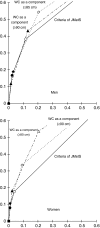Abdominal circumference should not be a required criterion for the diagnosis of metabolic syndrome
- PMID: 21432550
- PMCID: PMC2886890
- DOI: 10.1007/s12199-009-0132-7
Abdominal circumference should not be a required criterion for the diagnosis of metabolic syndrome
Abstract
Background: Metabolic syndrome (MetS) is an established concept. However, it is characterized by a number of different definitions as well as different cut-off points (COPs) for waist circumference (WC) and different modes for incorporating WC into the diagnostic criteria.
Methods: Abdominal ultrasonography was performed in 2,333 subjects who also underwent comprehensive medical examinations between April and July 2006. The odds ratios for the number of MetS components were calculated by taking central obesity status into account and considering concurrent fatty liver as an independent variable. We compared the areas under the receiver operating characteristic (ROC) curves for fatty liver and MetS using several MetS criteria.
Results: Regardless of the WC criterion selected, we observed a strong linear trend for an association (trend P < 0.0001) between MetS and the number of components. The odds ratio (OR) of subjects without central obesity but with all three MetS components was 9.69 (95% confidence interval 3.11-30.2) in men and 55.3 (6.34-483) in women. The COP for the largest area under the curve in men and women was ≥82 cm (OR 0.701) and ≥77 cm (OR 0.699), respectively, when WC was considered as a component. When WC distribution is taken into consideration, practical and appropriate COPs should be ≥85 cm for men and ≥80 cm for women.
Conclusion: We suggest that a WC of ≥85 cm for men and ≥80 cm for women would be optimal COPs for the central obesity criteria in the Japanese population. In addition, central obesity should be incorporated as a component of MetS rather than an essential requirement for the diagnosis of MetS.
Figures
References
-
- Matsuzawa Y. Definition and history of metabolic syndrome. Nippon Rinsho. 2006;64:9–12. - PubMed
-
- Wlodarczyk A, Strojek K. Glucose intolerance, insulin resistance and metabolic syndrome in patients with stable angina pectoris. Obesity predicts coronary atherosclerosis and dysglycemia. Pol Arch Med Wewn. 2008;118:719–726. - PubMed
LinkOut - more resources
Full Text Sources
Miscellaneous

